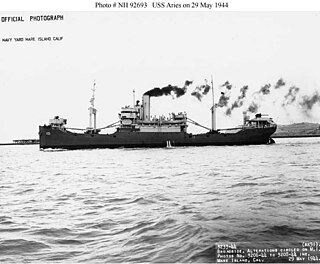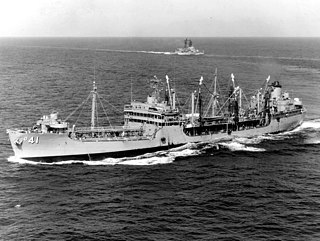
USS Rainbow (AS-7) was the only ship in the United States Navy by that name. The ship was originally converted to a distilling ship in 1898, and then converted again in 1917 to a submarine tender.

USS Patoka (AO–9/AV–6/AG–125) was a replenishment oiler made famous as a tender for the airships Shenandoah (ZR-1), Los Angeles (ZR-3) and Akron (ZRS-4). It was also notable in that its height figured prominently in the design of the Rainbow Bridge in Texas.

USS Galveston (C-17/PG-31/CL-19) was a Denver-class protected cruiser in the United States Navy during World War I. She was the first Navy ship named for the city of Galveston, Texas.

The sixth USS Relief (AH-1), the first ship of the United States Navy designed and built from the keel up as a hospital ship, was laid down 14 June 1917 by the Philadelphia Navy Yard; launched 23 December 1919; and commissioned 28 December 1920 at Philadelphia, Commander Richmond C. Holcomb, Medical Corps, USN, in command.

USS Cuyama (AO-3) was a tanker of the United States Navy launched 17 June 1916 by Mare Island Navy Yard; sponsored by Miss M. Offley; and commissioned 2 April 1917, Lieutenant I. B. Smith, USNRF, in command.

USS Sara Thompson (SP-3148/AO-8) was a tanker in the United States Navy. She was purchased at the start of World War I by the U.S. Navy and served as a tanker supporting American troops in Europe. Post-war she operated in the Pacific Ocean, supporting Navy operations in the Guam, China, and the Philippines. Because of her age and deteriorating condition, she spent her final days in the US Navy as a receiving hulk in the Philippines.

USS Alameda, was a United States Navy tanker in commission from 1919 to 1922. She was built as the civilian tanker SS Alameda, but transferred to the U.S. Navy after completion in 1919. She was sold for commercial service and operated under the names SS Olean and SS Sweep before she was transferred to the Navy again in World War II as USS Silver Cloud (IX-143).

USS Guadalupe (AO-32), a Cimarron-class fleet replenishment oiler that served in the United States Navy, it was named for the Guadalupe River in Texas.

USS Salinas (AO-19), a United States Navy Patoka-class replenishment oiler, was laid down for the United States Shipping Board (USSB) as Hudsonian (219592) on 10 April 1919 by the Newport News Shipbuilding and Dry Dock Co., Newport News, Virginia; launched on 5 May 1920; accepted by the USSB on 13 May 1920; transferred to the Navy on 29 October 1921; renamed Salinas and designated AO-19 on 3 November 1921; and commissioned at Mobile, Ala., on 16 December 1921.

USS Aries (AK-51) (1918–1952) was a United States Navy cargo ship built as Lake Geneva under a United States Shipping Board (USSB) contract in 1918 at Duluth, Minnesota, by the McDougall Duluth Shipbuilding Company, to augment American logistics capability during World War I. The freighter was delivered to the Navy at Montreal, Quebec, Canada, on 21 September 1918 and was placed in commission the following day for service in the Naval Overseas Transportation Service with Lieutenant Commander Francis A. Brannen, USNRF, in command. Aries was named for the constellation.

USS Mattaponi (AO-41) was a Kennebec-class oiler which served in the United States Navy during World War II, periodically during the 1950s, and in the Vietnam War. She was the only U.S. Navy ship named for the Mattaponi River in eastern Virginia.

The second USS Monongahela (AO-42) was a Kennebec-class oiler in the United States Navy which saw service during World War II and the Korean War. She was the second U.S. Navy ship named for the Monongahela River in West Virginia and Pennsylvania.
USS Saranac (AO-74), originally named the SS Cowpens, was a Type T2-SE-A1 Suamico-class fleet oiler of the United States Navy, and the fourth ship of the Navy to bear the name.

The second USS Mars (AC-6) was a collier of the United States Navy. The ship was laid down by the Maryland Steel Co., Sparrows Point, Maryland on 5 October 1908, launched on 10 April 1909, sponsored by Miss Juliana Keyser, and commissioned at Norfolk on 26 August 1909, Master A. B. Randall, Naval Auxiliary Service, in command. She was the sister of the USS Hector (AC-7).

USS Brutus, formerly the steamer Peter Jebsen, was a collier in the United States Navy. She was built in 1894 at South Shields-on-Tyne, England, by John Readhead & Sons and was acquired by the U.S. Navy early in 1898 from L. F. Chapman & Company. She was renamed Brutus and commissioned at the Mare Island Navy Yard on 27 May 1898, with Lieutenant Vincendon L. Cottman, commanding officer and Lieutenant Randolph H. Miner, executive officer.

USS Silverstein (DE-534) was a John C. Butler-class destroyer escort in service with the United States Navy from 1944 to 1947 and from 1951 to 1958. She was sold for scrapping in 1973.

USS Enoree (AO-69) was a Chiwawa-class oiler constructed for the United States Navy during World War II. She was the only U.S. Navy ship named for the Enoree River in South Carolina.

W. L. Steed was a steam tanker built in 1917–1918 by Bethlehem Shipbuilding Corporation of Quincy for Pan American Petroleum and Transport Company, with intention of transporting oil and petroleum products between Mexican and Gulf ports and the Northeast of the United States. The ship was briefly requisitioned by the US Government during World War I but returned to commercial service in early 1919. The ship was named after William L. Steed, superintendent of the Mexican Petroleum Company of California.

USS Supply, ex-Illinois, was a schooner-rigged iron steamer built in 1873 by William Cramp & Sons of Philadelphia. Illinois was purchased by the Navy Department from the International Navigation Company on 30 April 1898 for $325,000.00 and commissioned as Supply, Lt. Comdr. R. R. Ingersoll in command.

The McDougall Duluth Shipbuilding Company was a large-scale wartime ship manufacturing shipyard, located at the city of Riverside, near Duluth. McDougall Duluth Shipbuilding was at 110 Spring Street, Duluth, Minnesota, now the site of the West Duluth's Spirit Lake Marina. The shipyard was located on St. Louis River Estuary at western part of Lake Superior. McDougall Duluth Shipbuilding Company was found by Alexander McDougall (1845-1923) in 1917 to built ships for World War I. McDougall Duluth Shipbuilding Company and the Superior Shipbuilding Company were called the Twin Ports shipbuilding industry of Minnesota and Wisconsin. Once built the ships can travel to the Atlantic Ocean through the Great Lakes and the Saint Lawrence Seaway.



















